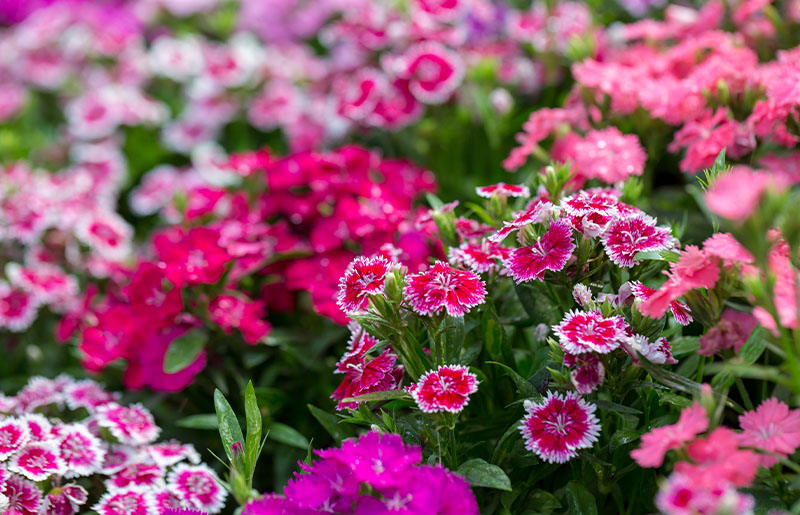
Plant of the Month: Dianthus
by Becky Lowicki, Harris County Master Gardener
Amazingly when the latest subfreeze left most landscapes the color of a wheat field, I spotted the vibrant green foliage of Dian- thus peeking out of the bedding around my shivering roses. Much to my surprise, within a week’s time, regal purple blooms the color of gemstones emerged, lifting their faces to the sun as if to say – “we made it!”
It’s important to note, these hardy specimens were the exact same Dianthus plants that had survived the winter wallop exactly two years ago – making them the ultimate cold-hardy perseverance plants. Granted they, like everything else, took a while to regroup after that ice-fest, but they came back in full color again without much tending on my part.
Mostly evergreen, these cool season bloomers are at their peak in early spring through early summer as seen in fragrant pink, white, rose, purple or combination-colored flowers. A bounty of blooms develops on stems above the foliage.
The Dianthus genus includes an astounding array of more than 27,000 registered cultivar names, which are grown as annuals, biennials and evergreen perennials.
These old-fashioned garden plants are often mislabeled, but generally comprise single-flowered varieties which are known as ‘pinks,’ and hardy double forms known as ‘carnations.’
Pinks are bushy plants with gray-green leaves and small flowers that can be single, semi-double or frilled, in shades of lavender, pink, purple, red, salmon and white. Each flower has toothed petals creating a delicate fringe. Pinks get their name not from the color, but from the fact that their fringy petals that look like they've been cut with pinking shears. Some species have a spicy fragrance, much like cloves.
Pinks (D. chinesis) are low-growing annu- als. Pinks, and hybrids bred from pinks, are the most commonly planted varieties.
Perennial dianthus is often called sweet William, due to its spicy fragrance with hints of clove and cinnamon. Re- lated to carnations, but much smaller and more delicate, di- anthus plants make a cheerful addition to any garden.
Carnations (D. caryophyl- lus) are taller and popular in the floral industry for bou- quets, but tend to be less hardy than other dianthus.
‘Bath’s Pink,’ a cultivar of D. gratianopolitanus, the perennials known as ‘cheddar pinks,’ will tolerate full sun, heat and humidity. It has blue-tinged foliage and single pink blooms with red eyes.
The tri-color blooms of Dianthus ‘First Love’ (D. caryophyllus), open initially as white, then turn to pink and eventually lavender. Its blossoms are fragrant and reported to be resistant to fungus disease.
Culture
Most varieties prefer morning sun, afternoon filtered shade and moderate moisture.
Growth Habit
The dense foliage is mostly evergreen, grassy or mat-forming green or gray, depending on the variety. Dianthus may be used in borders or containers, and make excellent bedding plants when massed together.
Source: Harris County Master Gardeners Urban Dirt Newsletter (February 2023 Edition)
About Urban Dirt
Each month, Harris County Master Gardeners publishes an informative, resourceful newsletter entitled "Urban Dirt". This article was derived from the February 2023 edition. To read the February 2023 edition of this newsletter, click the button below.
URBAN DIRT - FEBRUARY 2023 EDITION









